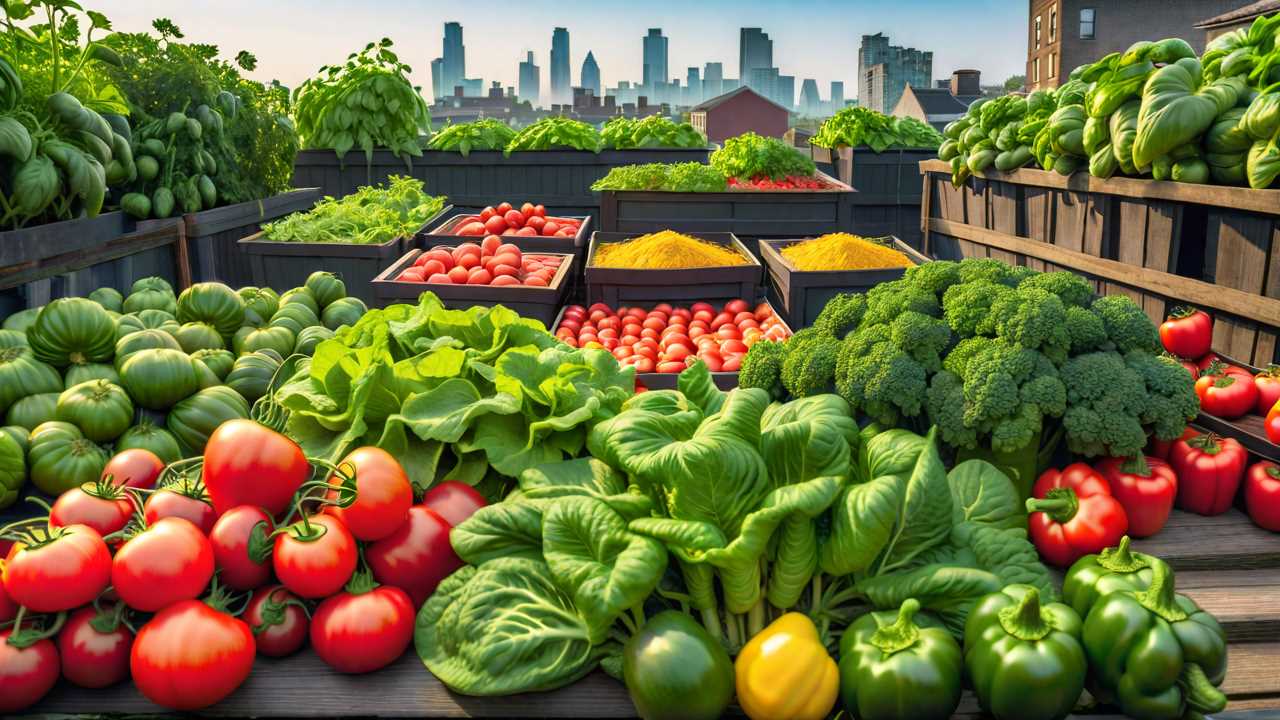
Did you know that rooftop vegetable gardening can be a feasible and rewarding endeavor? With the right approach, you can transform your rooftop into a flourishing garden that yields fresh produce right at your doorstep. But before you start planting, there are key considerations to keep in mind that will impact the success of your rooftop garden. From selecting the appropriate vegetables to understanding the challenges you may encounter, there are essential factors to investigate that will guide you towards a thriving rooftop vegetable garden.
Benefits of Rooftop Vegetable Gardening
Growing vegetables on your rooftop provides numerous benefits, including maximizing space utilization and promoting sustainability in urban environments. When you utilize your rooftop for vegetable gardening, you're making efficient use of space that would otherwise go unused. Rooftop gardens can significantly increase your available planting area, allowing you to grow a variety of vegetables even in a limited space.
Moreover, rooftop vegetable gardening contributes to sustainability by reducing heat absorption in urban areas. The vegetation on your rooftop helps to lower the overall temperature, mitigating the urban heat island effect prevalent in cities.
Additionally, these gardens aid in reducing stormwater runoff by absorbing rainwater that would otherwise flow into drainage systems.
Choosing the Right Vegetables
When selecting vegetables for rooftop gardening, consider the specific requirements of each plant to guarantee successful growth in your urban environment. Opt for vegetables that thrive in containers, have a shallow root system, and can withstand wind and sun exposure. Good choices include tomatoes, peppers, lettuce, radishes, and herbs like basil, parsley, and chives. These plants are well-suited for rooftop gardens due to their adaptability and compact growth habits.
Tomatoes are popular for rooftop gardening as they can be grown in pots and require support for their vines. Peppers, both sweet and hot varieties, also do well in containers and need ample sunlight. Lettuce is a great option for rooftop gardens because it grows relatively quickly and can be harvested multiple times. Radishes are root vegetables that mature rapidly, making them a convenient choice for rooftop gardening.
Herbs like basil, parsley, and chives are fantastic additions to a rooftop garden as they're versatile, compact, and add flavor to your dishes.
Overcoming Challenges
To succeed in rooftop vegetable gardening, you must address and navigate various challenges that may arise in your urban setting. One common challenge is the weight limit of your rooftop. Make sure to consult with a structural engineer to confirm that your rooftop can support the additional weight of soil, plants, and containers.
Another challenge is the limited space available on rooftops. Utilize vertical gardening techniques such as trellises, hanging planters, and stacking pots to maximize your growing area.
Furthermore, rooftop gardens are more exposed to harsh weather conditions like wind and intense sunlight. Install windbreaks, use shade cloths, and provide adequate watering to protect your plants. Additionally, access to water on rooftops can be challenging. Consider installing a drip irrigation system or using rain barrels to efficiently water your vegetable garden.
Lastly, pests and pollination can be problematic in urban settings. Implement pest control measures such as companion planting, row covers, and natural predators to protect your crops. To aid in pollination, consider planting pollinator-attracting flowers nearby.
Tips for Success
Maximize growth and yield by regularly monitoring and adjusting the pH level of your rooftop garden soil. Vegetables thrive in soil with a pH between 6.0 and 7.0, so use a pH meter to test your soil and make necessary adjustments using organic soil amendments like compost or sulfur.
Guarantee adequate drainage by using raised beds or containers with drainage holes. Rooftop gardens can suffer from poor drainage, which can lead to root rot and other issues. Use lightweight soil mixes that contain perlite or vermiculite to improve drainage and aeration.
Select vegetables that are well-suited for rooftop gardening, such as tomatoes, peppers, lettuce, and herbs. These plants are generally compact, have shallow root systems, and can thrive in containers or small raised beds.
Water consistently and deeply, especially during hot weather. Rooftop gardens can dry out quickly due to exposure to sun and wind. Consider installing a drip irrigation system or using self-watering containers to ensure your plants receive adequate moisture.
Lastly, provide sufficient sunlight by placing your rooftop garden in a location that receives at least 6-8 hours of direct sunlight per day. Adequate sunlight is essential for photosynthesis and healthy plant growth.
Frequently Asked Questions
When looking for the best rooftop vegetable gardening tools, consider lightweight hand tools, a quality watering can, durable gloves, a sturdy trowel, and a compact shovel. These essentials will help you efficiently tend to your rooftop garden.
How Can I Protect My Rooftop Garden From Pests?
To protect your rooftop garden from pests, consider installing physical barriers like mesh or row covers. Additionally, introduce companion plants such as marigolds or basil to deter unwanted insects. Regularly inspect plants for signs of infestation.
Is It Safe to Use Rainwater for Rooftop Gardening?
Using rainwater for rooftop gardening is safe with proper precautions. Install a filtration system to remove contaminants. Regularly clean gutters to prevent debris buildup. Test the water quality periodically to verify it's suitable for your plants.
Can Rooftop Gardens Attract Bees and Other Pollinators?
Indeed, rooftop gardens can serve as attractive habitats for bees and other pollinators due to the abundance of vegetation and flowers. These pollinators play a vital role in enhancing plant growth and promoting biodiversity.
How Can I Ensure Proper Drainage on My Rooftop for Gardening?
To guarantee proper drainage on your rooftop for gardening, start by installing raised beds with drainage holes. Use lightweight, well-draining soil and consider adding a layer of gravel at the bottom. Regularly check and clear any clogs.
 SportsHollywoodLifestyleFashionHome & GardenTrendsPrivacy PolicyTerms And Conditions
SportsHollywoodLifestyleFashionHome & GardenTrendsPrivacy PolicyTerms And Conditions
